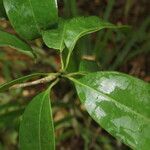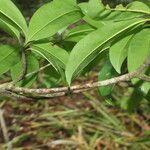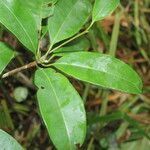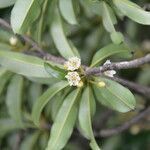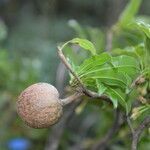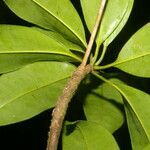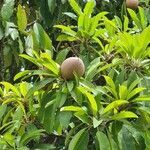A medium sized evergreen tree up to 18 m tall. It can grow to 30 m in tropical regions. The leaves are 8-12 cm long by 2-4 cm wide. The leaves are green and shiny. The leaves tend to be clustered in spirals near the ends of twigs. The flowers are single and white in the axils of leaves. They are bell like and 1 cm across and produced on long stalks. The fruit has several smooth black shiny seeds. The fruit are normally in pairs and 5-8 cm across. It is rusty brown in colour. The fruit can be seedless or can have up to 3 to 12 hard shiny seeds inside. The seeds are flattened and about 2 cm long. The tree has a milky juice. There are several named cultivated varieties.
(rarely all) their pubescence with age; corolla 6-11 mm long, the tube usually comprising 1/2-%3 the total length, the lobes oblong to ovate, 1.5-3 mm broad, entire or erose or dentate at the apex, lacking dorsal appendages; staminodes petaloid, rather narrowly ovate-lanceolate, 3-4.5 mm long, erose; stamens 2/3-3/4 as long as the staminodes; ovary densely sericeous, the style 4.5-8 mm long, glabrous except at the base, the apex often irregularly toothed or lobed. Fruit brown, mealy-roughened, ellipsoid or ovoid or subglobose, to 10 cm in diam; seeds brown, com-pressed, 16-24 mm long, the linear scar extending from near the base to beyond the middle.
Tree to 40 m. Leaves clustered toward the branch tips; petioles 0.8-3 cm long; blades elliptic or oblong-elliptic to somewhat obovate or oblanceolate, 4-15 cm long, 1.5-6 cm broad, subconcolorous, glabrate at maturity, the reticulation usually evident below. Flowers solitary in the leaf-axils; pedicels 1.2-2.5 cm long, rufous-tomentulose (some of the pubescence deciduous with age); sepals 6-10 mm long, ovate or occasionally oblong, tomentulose, the outer often losing some
